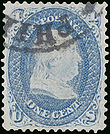We've talked about the most famous American postage stamp. But the Inverted Jenny, though highly valuable, is not the rarest. That honor belongs to the stamp known as the Z Grill.
In the stamp world, a grill is a pattern of indentations pressed into the paper. These indentations serve two purposes: first, they allow the ink of the cancellation to more readily be absorbed by the stamp, making it more difficult to reuse them. Second, the indentations are an anti-counterfeiting measure.
The Z Grill was a 1-cent stamp issued in 1868. It features a portrait of Benjamin Franklin in blue ink. The stamp's rarity stems from the unusual, Z-shaped grill. There were 10- and 15-cent stamps produced with the Z-shaped grill that are considered very rare as well, but there are only two of the Benjamin Franklin Z Grills known to exist today. Both of them are in circulated condition, and display cancellation marks that could be considered a testament to the effectiveness of putting grills on stamps.
One of the 1-cent Z Grills sold at auction in 1998 for $935,000. Even accounting for inflation, that's pretty impressive for something that originally cost a penny 130 years previously. But in an example of how an object is only worth what someone is willing to pay for it, this same stamp was traded in October 2005 for a four-stamp block of Inverted Jennies worth about $3 million. The buyer was motivated by his desire to have the only complete collection of American postage stamps from the 19th Century.
The other 1-cent Z Grill is owned by the New York Public Library, where it is on display.
Grilling fell out of favor in the 1870s, as concerns about stamp reuse faded. Since stamps from the era of grilling are often collectible, stamp collectors have extensively classified the various shapes of grills used, and how they affect the value of certain stamps.
Attribution for photo: Original uploader was Premkudva at en.wikipedia
